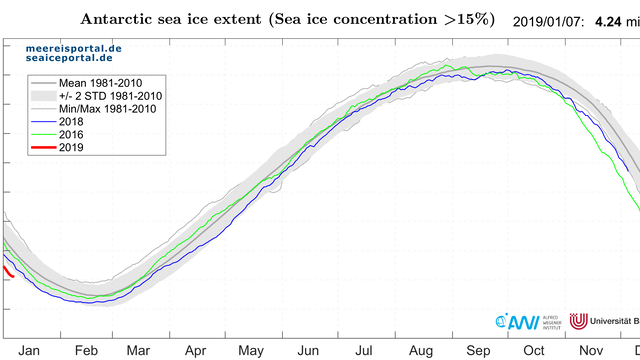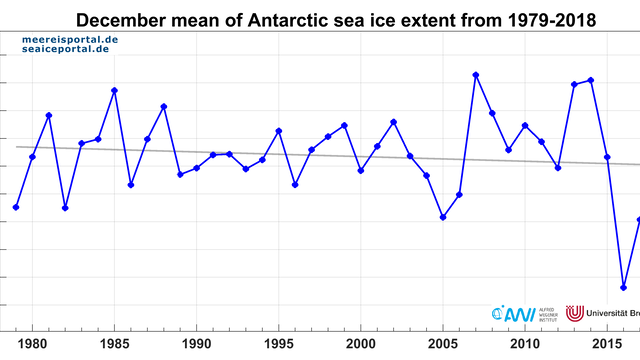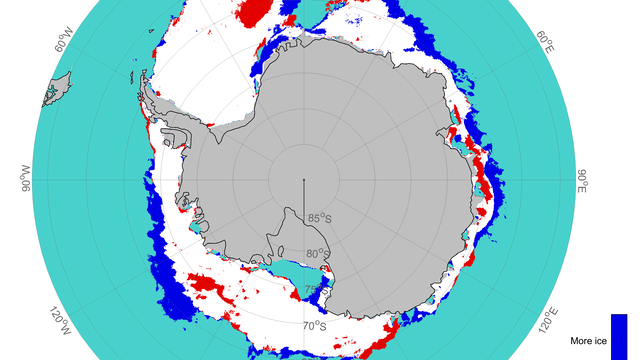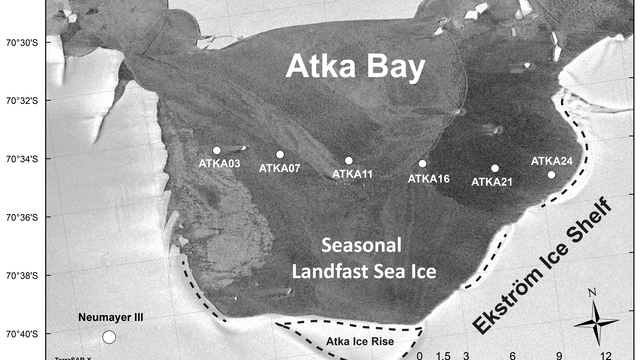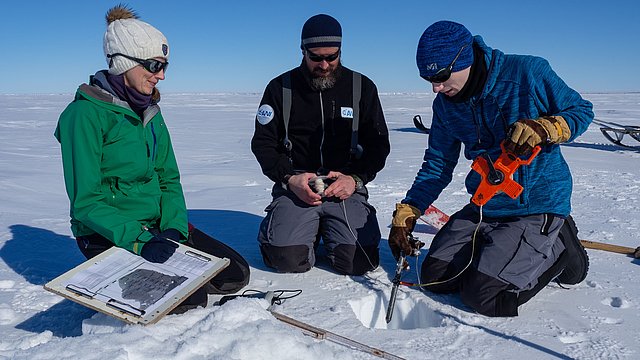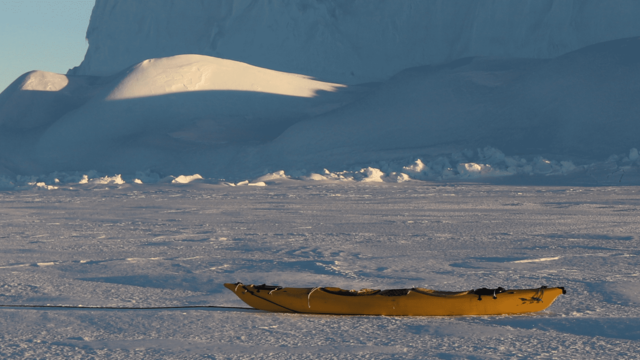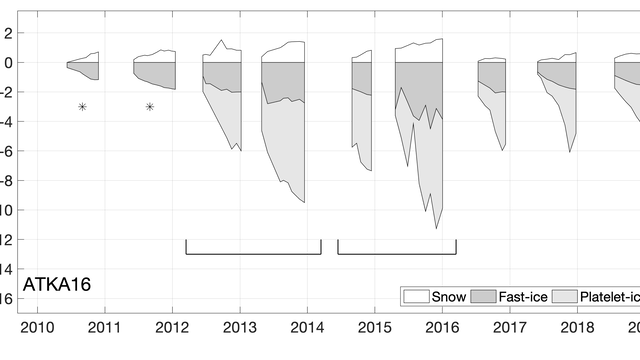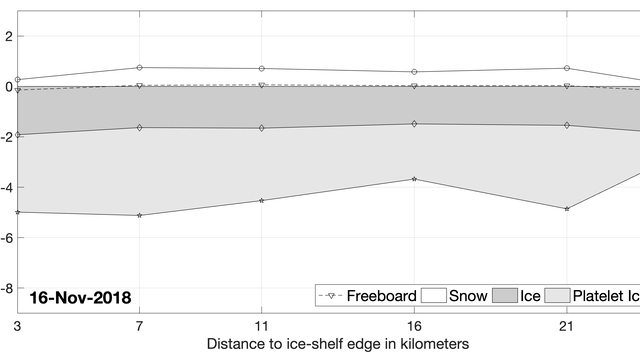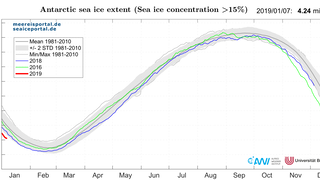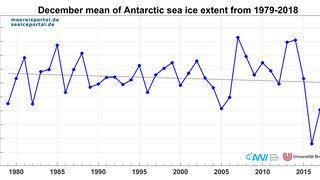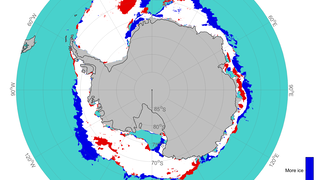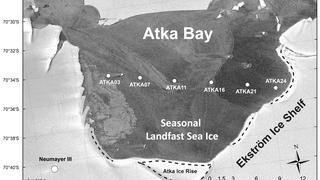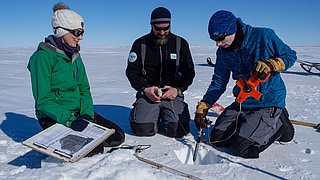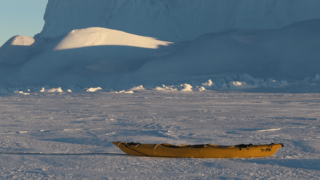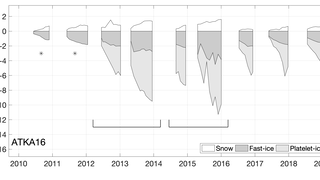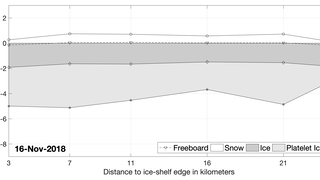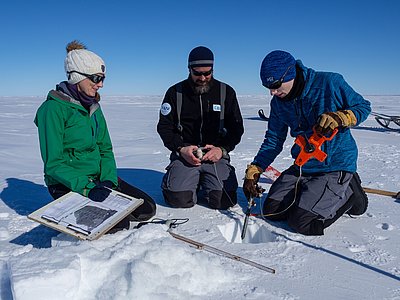In the course of the past few decades, the sea-ice extent in the Antarctic has been characterised by significant variability – both spatially and chronologically. For example, for the observational period from 1979 to 2010, a decrease of 5.1 ± 1.6% per decade was calculated for the Bellingshausen and Amundsen Seas, while in the Ross Sea, the sea-ice extent increased by 5.2 ± 1.4% (Parkinson & Cavalieri, 2012). If we consider all sectors of the ice-covered Antarctic Ocean, a slight increase in sea-ice extent can be seen during this period.
If we take a look at the latest ice maps for the Antarctic, we can see the lowest sea-ice extent at this time of year since the beginning of satellite observation (see Figure 1). In December, the monthly mean extent was only 8.5 million km² (see Figure 2). The next few weeks will tell us whether or not we’re heading toward an absolute sea-ice minimum in the Antarctic. However, whether or not this represents a clear trend toward lower sea-ice extents in the Antarctic Ocean in general is something that only observations and measurements gathered in the respective regions over the next several years can tell us.
Fast ice: A core component of Antarctic sea ice
When we talk about these changed sea-ice extents, for the most part we are referring to pack ice, i.e., sea ice that moves along with oceanic and atmospheric circulation systems. In addition, there are regions on the (ice shelf) coasts of the Arctic and Antarctic landmasses, as well as icebergs, where the sea ice has accumulated. This is known as fast ice, and offers a stable habitat for microorganisms and ice algae, not to mention a stable breeding ground for larger organisms like emperor penguins and seals. Accordingly, it is particularly important for the local ecosystem.
The German research and overwintering station Neumayer III in the Antarctic is located ca. 8 km from Atka Bay: a swell of the Ekström Ice Shelf, measuring roughly 25 km long (from east to west) and roughly 18 km across (from north to south), which is seasonally covered with fast ice. As a rule, the comparatively smooth fast ice in the bay breaks up and forms in a similar cycle every year, and can reach thicknesses of up to two metres.
Regular measurements on the fast ice in Atka Bay
In order to arrive at a better understanding of the processes at work, as well as the seasonal and interannual changes in the fast ice of Atka Bay, sea-ice measurements have been taken there on a regular basis since 2010. In this regard, the sea-ice section of the Alfred Wegener Institute has been actively contributing to the ‘Antarctic Fast Ice Network’ (AFIN), which was founded in connection with the International Polar Year (IPY). A number of international cooperation partners have since joined the project, and have helped establish a routine schedule for taking measurements at or near their respective Antarctic research stations. Standard parameters recorded by AFIN members include snow thickness; ice thickness; freeboard (i.e., the difference between the height of the ice surface and sea level); the time at which the fast ice forms; and the time at which it (both temporarily and finally) breaks up.
The routine measurements in Atka Bay are taken by the overwintering team at the Neumayer Station from early spring to the thawing of the bay in January / February. Essentially, they gather measurements of snow, fast-ice and platelet-ice thickness along a uniform 24-km transect that covers the entire bay from west to east (see Figure 4). Within the international AFIN network, the AWI stands out for its continuity of measurements, and for its extensive time series. For the past two years, AWI sea-ice physicist Dr Stefanie Arndt has coordinated this fast-ice programme in Atka Bay. “It’s a real pleasure to work in the professional setting of our research station, and to see how the entire overwintering team pursues its sea-ice work with such unparalleled commitment,” she explains. “There is no single person overwintering at the station who is responsible for sea-ice measurements; instead, our main contact partner is the station meteorologist. In the past season, that was Hanno Müller. As for the monthly sea-ice measurements, everyone at the station with the time and energy to help lends a hand.” During the latest Antarctic summer, Arndt herself spent a month at the station. Her goal: not just to gain a better insight into the routine measurements taken on site, but to also gather additional measurements in Atka Bay, so as to better understand the spatial distribution of the sea-ice, platelet-ice and snow thickness.
Measurement principles in Atka Bay
In Atka Bay, the snow, fast-ice and platelet-ice thickness are normally measured in one of three ways: (1) manual measurements at six fixed points throughout the bay; (2) continuous ice-thickness measurement using non-invasive electromagnetic (EM) methods along the snowmobile transects across the bay; or (3) installing autonomous platforms (buoys) on the fast ice to measure the snow and ice thickness, and to assess processes at the interfaces between the atmosphere, snow, fast ice and ocean. Describing her work in Atka Bay, Arndt recalls: “In November we especially expanded the programme for manual and EM measurements in Atka Bay by numerous additional measurements. To do so, we defined additional transects from south to north and from west to east, along which we drilled and measured at regular intervals” (see Figures 5 and 6).
Fast-ice development in Atka Bay over the past nine years
The fast ice in Atka Bay is predominantly seasonal. Exceptions include the years 2013 and 2016, in which stranded icebergs prevented the bay’s ice from breaking up in the summer. Accordingly, the entire observational period from 2010 to 2018 is characterised by significant interannual variability in the fast-ice, platelet-ice and snow thickness, but not by a chronological trend. The average seasonal fast-ice thickness is two metres. In terms of platelet-ice accumulation, the annual rate is estimated at ca. four metres. “As a result, for those years in which the blocking icebergs kept the fast ice from breaking up, we actually observed platelet-ice accumulation of up to eight metres,” Arndt explains (see Figure 7). The distribution of snow thickness on the fast ice of Atka Bay is also greatly influenced by the position of icebergs in the bay, but also by the region’s prevailing winds. According to the sea-ice physicist: “The weather in the region is dominated by prevailing easterly winds. Consequently, the measuring trips from west to east across Atka Bay show that, especially at the easternmost measuring points, there is only a very thin layer of snow, since most of it is swept away by the strong winds coming off the ice shelf” (see Figure 8).
All of these measurements are to be continued in the years to come, so as to supplement the existing time series. “Moreover, in the future we plan to put more emphasis on interdisciplinary research into the interplay between the atmosphere, ocean, fast ice and ice shelf in Atka Bay and the adjacent ice shelves,” Arndt explains. “This will allow us to draw conclusions regarding potential changes in the local ocean currents that could produce changes in both Antarctic and global water masses.”
Source
Parkinson, C. L., and D. J. Cavalieri (2012), Antarctic sea ice variability and trends, 1979-2010, Cryosphere, 6(4), 871-880, doi:10.5194/tc-6-871-2012.
Contact
Questions?
Contact us via E-Mail or our contact form.
Graphics
